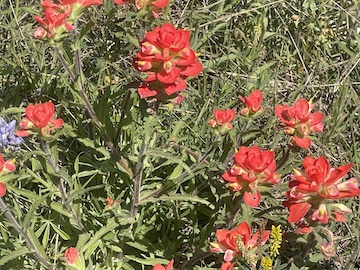This time of year Texans go crazier than they do at Christmas, and that’s saying something. It’s wildflower season, and everybody runs out in the fields to take pictures of their kids and dogs romping in bluebonnets, which makes no sense when you realize that they’re poisonous (the flowers, not your kids and dogs, probably) and also that rattlesnakes like bluebonnet fields just as much as you do.
The Texas Department of Transportation has a pretty wildflower brochure and even a wildflower hotline (800-452-9292) that will tell you where all the cool blooms are that day. If you call, please use the 800 prefix, because when you dial with the Alvarez County area code, you get one of the Black Orchids lines, which I answer. I try to be helpful, but I’m not promising I won’t just make stuff up if it’s a busy day.
And the traffic! I don’t know which is worse, people parking barely off the road and running off into the field or the people craning their necks to see the next patch of flowers, like they’ve never seen any before. So between the bad parkers and the flower gazers when they need to be road gazers–watch out.
I don’t know whether highways are natural habitats for wildflowers, but Texas has invested a lot of time and money planting them there, all 2700 varieties, to spiff the place up in spring. Spring came early this year, just like our little weather dude, Bee Cave Bob the Armadillo, said it would, and we weren’t far into March before bluebonnets popped out all over.

Depending on the weather, the soil, the temperature, and I don’t know what else, different species sprout up at different times and quantities. Bluebonnets toot the horn to begin the season, and if we had a rainy fall, we’ll have boatloads of bluebonnets. I’ve never heard anyone call those little white-tipped blue flowers anything but bluebonnets, but Johnny says their real name is Lupinus texensis. He would.
This year the Paintbrushes aren’t far behind, either time- or quantity-wise. My research tells me (You impressed? I did research.) that they can be cream, yellow, scarlet, orange, or purple, but I’ve never seen them in any other color but a Day-Glo reddish orange. JD calls them Texas Paintbrushes. Dianne calls them Scarlet Paintbrushes. My granny calls them Indian Paintbrushes, though I’ve told her not to do that; it’s rude. So I call them Paintbrushes, just to get along with everyone. Johnny, of course, calls them Castilleja indivisa.

As near as I can tell, the bluebonnets bloom first, then the red flowers, followed by whites and yellows, and finally pinks and purples. In the last group, mostly you’ll see this pink cup-looking thing. Here’s where the name wars get serious. My granny calls them Pink Ladies. Dianne says they’re Mexican Evening Primroses. JD calls them Buttercups. Evening Primroses are what I learned to call them in school, so that puts me on Team Primrose, but I try not to call them anything but “the pink ones.”
No one uses Johnny’s name of Oenothera speciosa.

Beware the B*****d Cabbage!
JD won’t let me say certain words in these posts, even when it’s the stupid name of the stupid flower. He says there’s alternatives. There are, but nobody uses them.
He won’t let me tell you the full name of DYC either. Okay, it’s D*** Yellow Composite, and it means the 20,000+ yellow aster-like species that nobody can tell the difference between anyway. I know a few of their names, like Black-Eyed Susans, Firewheels, and Coreopsis, but that’s it.
The one to watch out for is the plant with little yellow clusters. It goes by the names of turnip-weed, b*****d cabbage, common giant mustard, ball mustard, wild turnip, wild rape, and tall mustard-weed. If you see any of that, no matter what you call it, I’d appreciate it if you’d pull it up (but park off the road and listen for rattlesnakes, not that they always rattle). Both the country and the state declare it an invasive noxious weed, and it’s crowding out the Texas natives. How’d you like to drive down the highway and see nothing but this illegitimate cabbage?

To see the bright colors, get out on the Texas roads before Memorial Day–even earlier this year. But if you’re not going to be picky about which flowers you see, you can count on something in bloom well into November. Make your first stop the Ladybird Johnson Wildflower Center to get some expert knowledge, a good lunch, and some seed packets from the gift center to help keep Texas blue, red, white, pink, and purple–just not all yellow.

